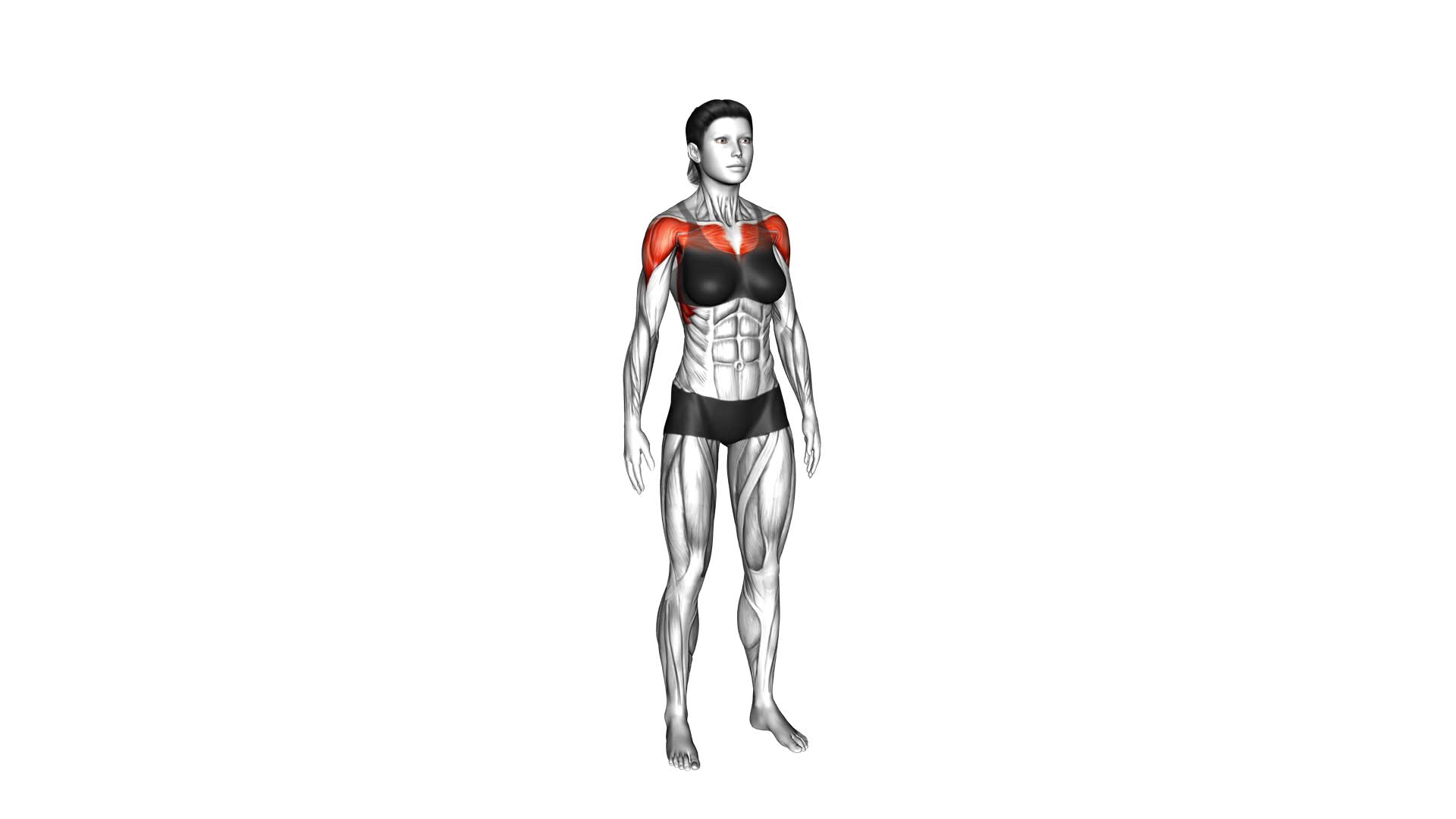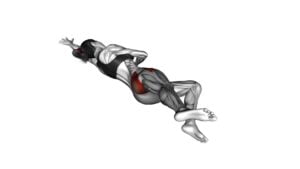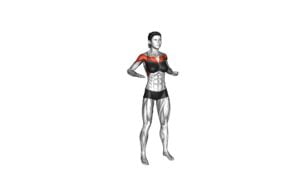Diagonal Front Scoop Raise(female) – Video Exercise Guide & Tips

Get ready to take your workout to the next level with the Diagonal Front Scoop Raise.
Watch This Exercise Video
This video exercise guide is designed specifically for females, providing you with the tips and techniques you need to maximize your results.
Learn about the benefits, proper form, common mistakes to avoid, and variations for continued challenge.
Incorporate the Diagonal Front Scoop Raise into your routine and watch as your strength and tone improve.
Let's get started!
Key Takeaways
- The Diagonal Front Scoop Raise is a beneficial exercise for maximizing workout effectiveness and improving shoulder and core strength.
- It activates multiple muscles in the upper body, with a focus on the deltoid muscles in the shoulders.
- Proper technique is important, including choosing the right equipment (dumbbells or resistance bands), maintaining proper posture, and avoiding swinging or using momentum.
- To increase difficulty and progress the exercise, you can add weight, change the tempo, increase the range of motion, and incorporate variations and progressions.
Benefits of the Diagonal Front Scoop Raise
To maximize the effectiveness of your workout, incorporate the diagonal front scoop raise into your routine for improved shoulder and core strength. This exercise is highly beneficial for achieving maximum results and activating multiple muscles in your upper body.
The diagonal front scoop raise primarily targets the deltoid muscles in your shoulders. By lifting your arms diagonally across your body, you engage both the front and side delts, resulting in a well-rounded shoulder workout. This exercise also activates the muscles in your upper back and chest, providing a comprehensive upper body workout.
In addition to shoulder strength, the diagonal front scoop raise also helps to strengthen your core muscles. As you lift your arms diagonally, you engage your core to stabilize your body and maintain proper form. This not only improves your core strength but also enhances your overall stability and balance.
Incorporating the diagonal front scoop raise into your workout routine is a great way to maximize your results. By activating multiple muscles in your upper body, you can significantly improve your shoulder and core strength. So, next time you hit the gym, be sure to include this exercise for a more effective and efficient workout.
Equipment and Setup for the Exercise
To ensure optimal results from the Diagonal Front Scoop Raise exercise, it's important to choose the right equipment and set up correctly.
The optimal equipment choices for this exercise include dumbbells or resistance bands.
To set up correctly, stand with your feet shoulder-width apart, hold the dumbbells or resistance bands in your hands, and keep your arms straight and extended in front of you.
Optimal Equipment Choices
Choose the appropriate equipment and set it up correctly for the Diagonal Front Scoop Raise exercise.
When it comes to optimal equipment choices, you'll need a dumbbell or a resistance band. A dumbbell is a great option if you want to add resistance to the exercise, allowing you to challenge your muscles effectively. On the other hand, if you prefer a more portable and versatile option, a resistance band can provide the necessary resistance without the need for weights.
Additionally, alternative exercises such as lateral raises or front raises can be performed using the same equipment. These exercises target similar muscles and can be incorporated into your workout routine for variation.
Now that you understand the optimal equipment choices, let's move on to the correct exercise setup.
Correct Exercise Setup
First, make sure you have the appropriate equipment set up for the Diagonal Front Scoop Raise exercise. You'll need a pair of dumbbells that are comfortable for you to hold and lift. Choose a weight that challenges you but allows you to maintain proper form throughout the exercise.
To set up, stand with your feet shoulder-width apart and hold the dumbbells in each hand, palms facing your body. Keep your elbows slightly bent and your core engaged.
This exercise can be modified by using lighter or heavier weights, depending on your fitness level and goals. The primary muscles targeted are the deltoids, specifically the front and side delts.
Remember to always consult with a fitness professional before attempting any modifications to ensure proper technique and safety.
Proper Technique and Form for Maximum Results
To achieve maximum results from the Diagonal Front Scoop Raise exercise, it's important to focus on proper technique and form. Here are some essential tips to keep in mind:
- Maintain a slight bend in your knees.
- Engage your core for stability.
- Avoid swinging or using momentum to lift the weight.
Essential Form Tips
Mastering proper form is crucial for achieving maximum results with the Diagonal Front Scoop Raise exercise. To ensure you're performing this exercise correctly, here are some essential form tips:
- Maintain proper posture: Keep your back straight, shoulders relaxed, and core engaged throughout the movement. Avoid rounding your back or hunching your shoulders.
- Control the movement: Slowly raise the dumbbell diagonally across your body, focusing on the contraction of your shoulder muscles. Avoid swinging or using momentum to lift the weight.
- Keep your arms slightly bent: Avoid fully extending your arms at the top of the movement to maintain tension on the shoulder muscles.
- Start with lighter weights: It's better to start with lighter weights and focus on proper form than to use heavier weights and sacrifice technique.
Optimizing Muscle Activation
To optimize muscle activation and achieve maximum results, focus on maintaining proper form and technique during the Diagonal Front Scoop Raise exercise. This exercise targets the deltoids and upper body muscles, making it essential to perform it correctly.
Begin by standing with your feet shoulder-width apart, holding a dumbbell in each hand. As you raise your arms diagonally in front of your body, keep your elbows slightly bent and your palms facing down. Engage your core and avoid swinging or using momentum to lift the weights.
Slowly lower the dumbbells back to the starting position, maintaining control throughout the movement. By following these muscle activation techniques, you can ensure that your muscles are properly engaged and maximize your results from this exercise.
Common Mistakes to Avoid
Avoid these common mistakes when performing the diagonal front scoop raise exercise. To ensure you're getting the most out of this exercise and avoiding potential injury, pay attention to the following technique tips:
- Using too much momentum: Many people tend to use their entire body to swing the weight up instead of relying on the targeted muscles. Remember, this exercise is about controlled movements and isolating the muscles in your shoulders and upper back.
- Lifting too heavy: It's important to choose an appropriate weight that allows you to maintain proper form throughout the exercise. Lifting too heavy can lead to compromised technique and increase the risk of injury.
- Neglecting proper posture: Keep your spine straight, shoulders back, and core engaged throughout the movement. Avoid hunching your shoulders or arching your back, as this can strain your neck and lower back.
- Not completing the full range of motion: Make sure to fully extend your arms and raise the weight as high as possible without compromising your form. Avoid cutting the movement short, as this will limit the effectiveness of the exercise.
Variations and Progressions for Continued Challenge
Looking to increase the challenge of the diagonal front scoop raise exercise? There are several variations and progressions you can incorporate to continue challenging your muscles and making progress in your fitness journey.
One variation you can try is adding resistance to the exercise. Instead of using just your body weight, you can hold a dumbbell or a resistance band to increase the difficulty. This will require your muscles to work harder, resulting in greater strength gains.
Another variation is changing the tempo of the exercise. Instead of performing the movement at a regular pace, you can slow down the lowering phase and pause briefly at the bottom before raising your arms again. This will increase the time under tension for your muscles, leading to greater muscle activation and growth.
To further progress the exercise, you can increase the range of motion. Start by performing the diagonal front scoop raise with your arms at shoulder height, and gradually increase the range of motion by raising your arms higher. This will challenge your muscles in a different way and help you continue making progress.
Incorporating these variations and progressions into your workout routine will keep your muscles guessing and prevent plateaus. Remember to always listen to your body and progress at a pace that's challenging yet manageable for you.
Tips for Incorporating the Diagonal Front Scoop Raise Into Your Workout Routine
As you continue to challenge your muscles with variations and progressions, it's important to incorporate the diagonal front scoop raise into your workout routine regularly. This exercise not only targets multiple muscle groups but also offers different exercise variations to keep your workouts interesting and effective.
Here are some tips for incorporating the diagonal front scoop raise into your workout routine:
- Start with the basic movement:
Begin by standing with your feet shoulder-width apart, holding a dumbbell in one hand. Extend your arm diagonally across your body, lifting the weight in a sweeping motion towards the opposite shoulder. Lower the weight back down and repeat on the other side. This exercise targets your deltoids, biceps, and upper back muscles.
- Increase the challenge with resistance bands:
To add more resistance to your diagonal front scoop raise, try using resistance bands. Attach one end of the band to a stationary object and hold the other end in your hand. Perform the same sweeping motion, feeling the resistance in your muscles as you lift the band.
- Incorporate unilateral movements:
Instead of using both arms simultaneously, try performing the diagonal front scoop raise one arm at a time. This unilateral movement helps to improve your stability and balance while engaging your core muscles.
- Vary the weight and repetitions:
To continuously challenge your muscles, alternate between heavier weights with fewer repetitions and lighter weights with higher repetitions. This variation helps to build strength and endurance in different muscle groups.
Frequently Asked Questions
How Many Repetitions and Sets Should I Do for the Diagonal Front Scoop Raise?
To achieve the best results with the diagonal front scoop raise, it's important to consider the repetition range and proper form.
The repetition range for this exercise typically falls between 8 to 12 repetitions per set. This ensures that you're challenging your muscles enough to promote growth and strength.
Additionally, maintaining proper form throughout the exercise is crucial to target the desired muscles effectively and avoid injury.
Can I Do the Diagonal Front Scoop Raise With Dumbbells Instead of a Barbell?
Yes, you can definitely do the diagonal front scoop raise with dumbbells instead of a barbell. Using dumbbells allows for more variety and can target different muscle groups.
The benefit of the diagonal front scoop raise is that it strengthens your shoulders and upper back, improving your posture and overall upper body strength.
Adding dumbbells to this exercise can increase the challenge and help you further develop your muscles.
Is the Diagonal Front Scoop Raise Suitable for Beginners?
The diagonal front scoop raise is a great exercise for beginners. It helps strengthen your shoulders, arms, and core muscles.
To perform it properly, stand with your feet shoulder-width apart, hold a dumbbell in one hand, and raise it diagonally across your body. Keep your arm straight and engage your core throughout the movement.
This exercise is suitable for beginners because it's simple yet effective in targeting multiple muscle groups.
How Often Should I Include the Diagonal Front Scoop Raise in My Workout Routine?
To maximize the benefits of your workout routine, it's important to include the diagonal front scoop raise. This exercise targets your shoulders, arms, and core muscles. By performing it correctly, you can improve your upper body strength and stability.
As for how often to include it, aim for 2-3 sets of 8-12 repetitions, 2-3 times a week. Remember to start with lighter weights and gradually increase as you become more comfortable and confident with the movement.
Are There Any Alternative Exercises That Target the Same Muscles as the Diagonal Front Scoop Raise?
If you're looking for alternative exercises that target the same muscles as the diagonal front scoop raise, you can try cable diagonal raises and dumbbell front raises. These exercises engage the same muscles as the diagonal front scoop raise and can provide a similar workout.
Cable diagonal raises involve pulling a cable at an angle across your body, while dumbbell front raises involve lifting dumbbells straight in front of you. Both exercises can help strengthen your shoulder and upper body muscles.
Conclusion
In conclusion, the diagonal front scoop raise is a highly effective exercise for targeting the upper body muscles, particularly the shoulders and arms. By incorporating this exercise into your workout routine, you can improve your strength, posture, and overall fitness.
Remember to focus on proper form and technique to maximize your results and avoid common mistakes. With variations and progressions, you can continue to challenge yourself and see continued progress.
So give the diagonal front scoop raise a try and take your fitness to the next level.

Author
Years ago, the spark of my life’s passion ignited in my mind the moment I stepped into the local gym for the first time. The inaugural bead of perspiration, the initial endeavor, the very first surge of endorphins, and a sense of pride that washed over me post-workout marked the beginning of my deep-seated interest in strength sports, fitness, and sports nutrition. This very curiosity blossomed rapidly into a profound fascination, propelling me to earn a Master’s degree in Physical Education from the Academy of Physical Education in Krakow, followed by a Sports Manager diploma from the Jagiellonian University. My journey of growth led me to gain more specialized qualifications, such as being a certified personal trainer with a focus on sports dietetics, a lifeguard, and an instructor for wellness and corrective gymnastics. Theoretical knowledge paired seamlessly with practical experience, reinforcing my belief that the transformation of individuals under my guidance was also a reflection of my personal growth. This belief holds true even today. Each day, I strive to push the boundaries and explore new realms. These realms gently elevate me to greater heights. The unique combination of passion for my field and the continuous quest for growth fuels my drive to break new ground.



